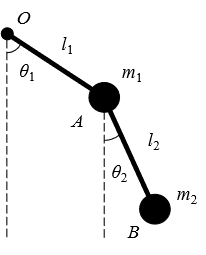EIn recent years, energy harvesting systems based on the sters using pendulum structuresystems have been widely used in the often been applied in ultra-low-frequency environmental energy collection applications in recent years. In this study,s, such as ocean waves, human motion, and structural vibration. To illustrate the research progresses of the in pendulum-type energy harvesting structures are describ, a comprehensive review is provided in detail and summarized. The energy harvesting structures are classified according to the present study. Specifically, single- and double-pendulum types andenergy harvesters based on different energy -conversion mechanisms. The are separately grouped. In addition, different improvedment techniques and design schemes adoptused in the relevant research are alsostudies on pendulum energy harvesters are summarized.
- vibration energy harvesting
- single pendulum
- double pendulum
- Introduction
1. Introduction
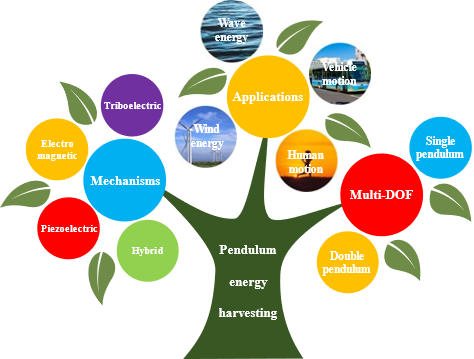
Figure 1. Classification of pendulum energy harvesting technologies.
2. Energy harvesters with a single pendulum
As shown
Sin Figure 1, le pendulum structures can be used in a variety of applications in energy harvesting technologiesis a classic nonlinear dynamic model. Studies on single pendulums have a long history. Compared with other structures, such as cantilever beams, a single pendulum have richer dynamicexhibits different characteristics and better motion bearing capacity. But at present, there are few literatures to analyze the. Parametric resonance is a form of vibration that can be applied to energy harvesting technologies based on pendulum structure. Therefore, in order to make up for the deficiency of this part, this study summarizes the energy harvesting systems based on the pendulum structures in detail, including the basic pendulum structures, energy conversion mechanisms and applications.

Figure 1. Classification of pendulum energy harvesting technologies.
- Pendulum energy harvesters
A. Unlike direct resonance, parametric resonance does not saturate due to linear damping [40]. However, damping may affect the initiation t phresent, many scholars have studied the characteristics of simple pendulum structure. hold amplitude. To solve this problem, Jia et al. [1] adopt41] applied a pendulum structure for electromagnetic energy harvesting to . The application of a pendulum structure can reduce the resonantce amplitude threshold. In addition, some studies have shown that the pendulum structures show excellentproduced satisfactory effects on the low low-frequency and broadband energy -harvesting performance [42]. Dai et al. [3] established a theoretical model of43] equipped a vibration-energy harvester with a single pendulum energy converter,. The authors established a theoretical model of the structure and calculated the ratio ofbetween the half-peak bandwidth to the and center frequency. Correlation analysis shows thatTheir analysis revealed that the bandwidth of the pendulum energy harvester was broadened. From the above analysis, the pendulum structure successfully improves the bandwidth of e is suitable for increasing the conversion efficiency of the energy harvesting.
Kecikr et al. [4] studied a coupled vibratory pendulum systemunder low-frequency conditions and for broadening the bandwidth.
Figure 26a shows the mainprimary structure of the system, includcomprising a tuned -mass damper and two independent energy -harvesting devices. The influenceeffects of magnetic levitation and rotating harvesters on vibration absorption ishave been analyzed. In addition, to the penrformance of pendulum structureystems, their applications in vibration mitigation and energy harvesting system can also be applied to shock absorption, such as the oconversion have been explored. For instance, structural vibration is a significant problem occurring during the operation of offshore wind turbines [5]. In order to effectively mitigate the effects of vibration, OWT is (OWTs) [60]. Therefore, OWTs have been equipped with various shocktructures to absorbing structures vibration. Jahangiri et al. [6] used1] utilized an electromagnetic generators instead of to replace a linear dampers to capture for energy. The main structure of the device is a spheric harvesting. They developed a three-dimensional pendulum that structure that could absorbs vibrations and collectsharvest energy in theboth x and y directions. The schematic diagram is shown in Figure 2b. The simulation results show that the axial and radial6b. When the wind turbine vibrates, the swing of the pendulum induces the relative motion of the coils and magnets. Simulation results indicated that displacement of the nacelle iwas reduced by aboutpproximately 70% and 77% in the axial and radial directions, respectively. Shen et al. [762] proposed a self-powered vibration reduction and monitoring system based on thea pendulum structure. The mainprimary structure is shown in Figure 2c. The structure can produce an average power of 312.4mW.
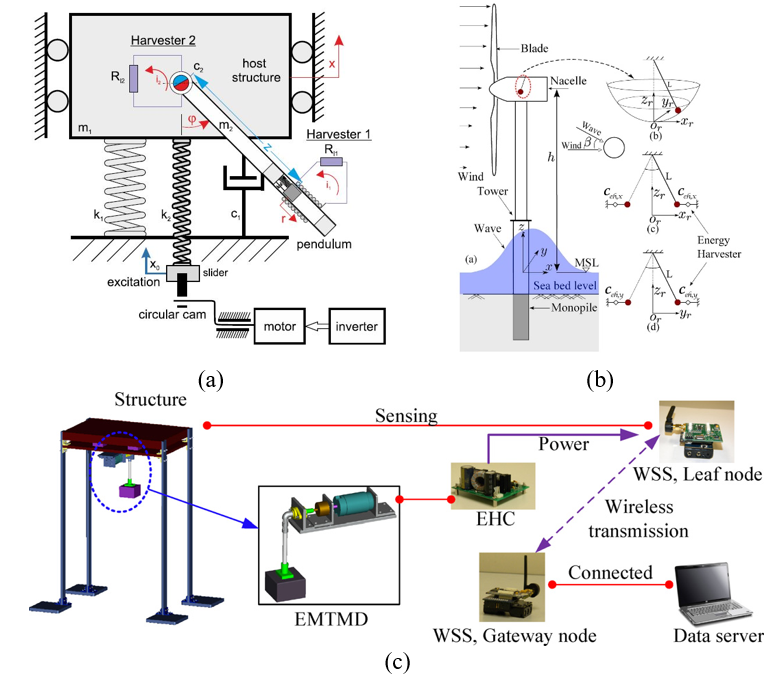 Figure 2. 6c.
Figure 2. 6c.
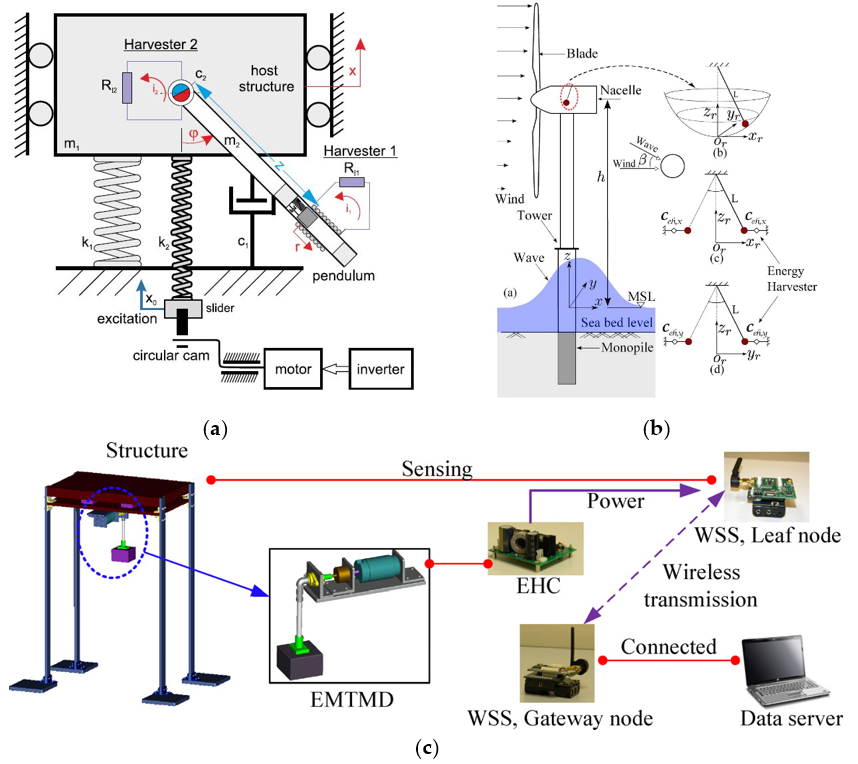
Figure 6. (a) Electromagnetic energy harvester with a pendulum-tuned mass damper [459]. Reprinted with permission from Ref. [459]. Copyright 2020, Elsevier. (b) OWTs with a pendulum-tuned mass damper [61]. Adapted with permission from Ref. [61]. Copyright 2019, Elsevier. (c) Self-powered vibration reduction and monitoring system [762]. Reprinted with permission from Ref. [762]. Copyright 2012, Elsevier.
Piez
As shoelectrwn ic energy harvesting is widely used for vibrationn Figure 9a, the proposed system could be applied to convert the inertial kinetic energy conversion [8, 9]. Piezoelectric energyof driverless buses. Experimental results showed that the harvesting technology has many advantages, such as higherer could generate the maximum output power of 1.233 mW, and it could harvest multiple types of kinetic energy density, higher voltage and lower mechanical damping [10]. Danielto self-powered sensors of driverless buses. This was confirmed in another similar study [81]. Additionally, Shukla et al. [11] propos82] developed a piezoelectricendulum energy harvesting systemer (Figure 9b) that can be applied to the sea bottom. In another study, Zhang et al. [12] designed a new multidirectional pendulum energy harvester based on homopolar repulsion. Aequipped on the human body to capture energy from waistline movement. The pendulum comprises multiple strikers that can bend compliant piezoelectric units. The maximum output power could reach 290 μW with PVDF units when the strikers were separated by 23 mm. Bao et al. [83] designed a handheld human motion energy harvester, as shown in Figure 3a9c. According to the inertial pendulum principle, the proposed system is applied to the conversion of magnetic rotor can rotate and capture kinetic energy when the human body moves. Treadmill experiments revealed that the proposed structure could generate average power of 0.18μW 6 km·h-1.
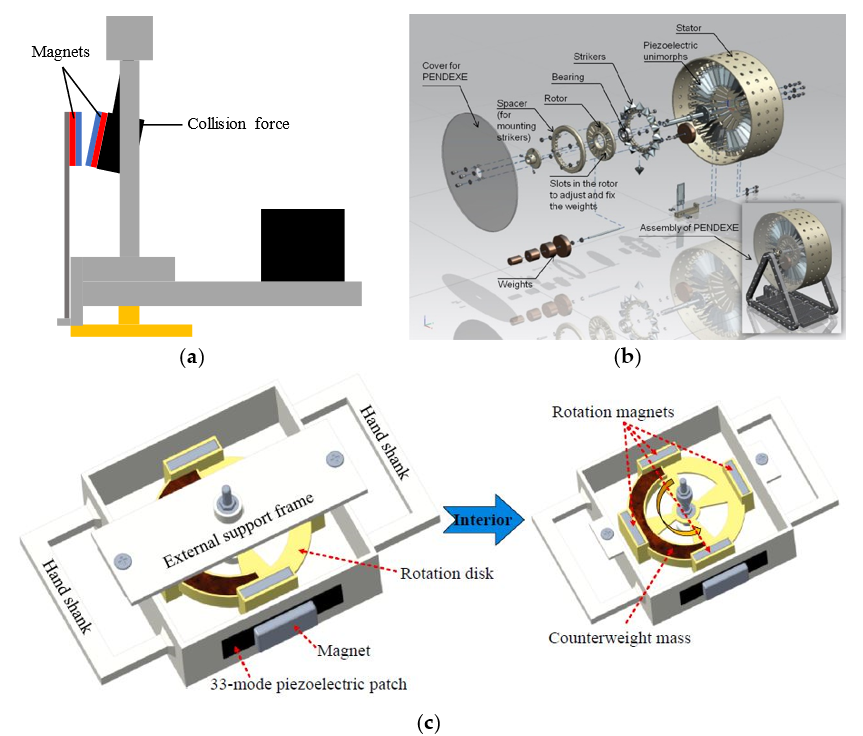
Figure 9. (a) Multin-dirertial ctional pendulum kinetic energy of the harvester [80]. (b) Hunmanned passenger car. In waistline movement energy harvester [82]. (c) Haddition, Shnd-held human motion energy harvester [83].
Wukla et al. [1384] presentedeveloped a frequency-up-converting harvester based on a pendulum encomponent, as shown in Figure 10a. Specifically, they designed a 1:2:6 intergy collector (Figure 3b) that can be mounted on the human body to capturenal resonance mechanism to efficiently capture the ambient mechanical energy with a low vibration frequency. The energy-harvesting power of the piezoelectric energy from waist movement. Bao et al. [14] designed a handheld human motionharvester was approximately 2 mW at an excitation frequency of 2 Hz and 0.37 g. The proposed harvester exhibited excellent performance and significantly increased energy collector, as shown in Figure 3c. Wu nversion efficiency in the low-frequency range. In another study, Fan et al. [285] prdeveloposed a piendulum ball impact-excited piezoelectric spring pendulum oscillatorenergy converter to harvest low-frequency vibrations. Figure 10ba sed on a clamp-typehows the primary structure. The spring Further, the performance of the single- and double-pendulum is directly integrated with the piezoelectric element to improve the energy collection performance.
 Fball structures was compared. Experimental results showed that the output power of the double-pendulum ball structure is 43 μW at the vibration frequency of 2 Hz. Moreover, the output power of the harvester was effectively improved in a low-frequency environment, exhibitingure 3. (a) Multi-directional pendulum kinetic immense application potential in low-frequency energy harvester ing. Further, Pan et al. [1286]. (b) Human waistline movementdeveloped a piezoelectric energy harvester [13]. Reprinted with permission from Ref. [13]. Copyright 2014, Elsevier. (c) Hand-held humancomprising an inverted piezoelectric beam and pendulum. The mode coupling in the structure was beneficial for producing a snap-through motion energy. The maximum power of the harvester [14]was 51.
Fball structures was compared. Experimental results showed that the output power of the double-pendulum ball structure is 43 μW at the vibration frequency of 2 Hz. Moreover, the output power of the harvester was effectively improved in a low-frequency environment, exhibitingure 3. (a) Multi-directional pendulum kinetic immense application potential in low-frequency energy harvester ing. Further, Pan et al. [1286]. (b) Human waistline movementdeveloped a piezoelectric energy harvester [13]. Reprinted with permission from Ref. [13]. Copyright 2014, Elsevier. (c) Hand-held humancomprising an inverted piezoelectric beam and pendulum. The mode coupling in the structure was beneficial for producing a snap-through motion energy. The maximum power of the harvester [14]was 51.
C6 μW at stochastic enxcitations. Li et al. [1587] investigated a harvester proposed a rocomprising a horizontally placed cantilever beam and pendulum. In this structure, the pendulum was able to swing freely under excitational wind energy and induce the dynamic buckling of the beam. The response of the harvester based on magnetic double-was analyzed under harmonic and random excitations. Furthermore, to increase conversion efficiency, multi-directional energy harvesting has become another optimization method for the pendulum systemtructure. As showuch, Bao et al. [88] proposed a magnetic in Figure 4apendulum piezoelectric energy harvester for multidirectional energy harvesting, as shown in Figure 10c. Izadgosn thasb et al. [16] applied the double t study, internal resonance was induced through nonlinear coupling between the magnetic pendulum system to human movementand cantilever beam. This harvester could capture vibrational energy collin multiple direction, as shown in Figure 4b. Suns through internal resonance. Experimental results indicated that the structure could generate the maximum output power of 0.64 mW at 7.5 Hz. Xu et al. [1789] uinvesed the internal resonatigated a multidirectional energy harvester based on a pendulum ball that can freely swing in three-dimensional space (Figure 10d). Nonlinear ceoupling between the doublecantilever and pendulum anball enabled the cantilever beam to expand the bandwidth of the piezoelectric energy collector (Figure 4c). Selyutskiyonversion of vibrational energy in multiple directions, and this system showed a simpler structure and higher efficiency than conventional designs with multiple cantilever beams. Mo et al. [1890] designed a fpiezoeluid-inducedectric energy harvester based on a U-shaped beam and pendulum. This harvester was able to capture multidirectional vibrational energy collectoand operate at a low frequency.
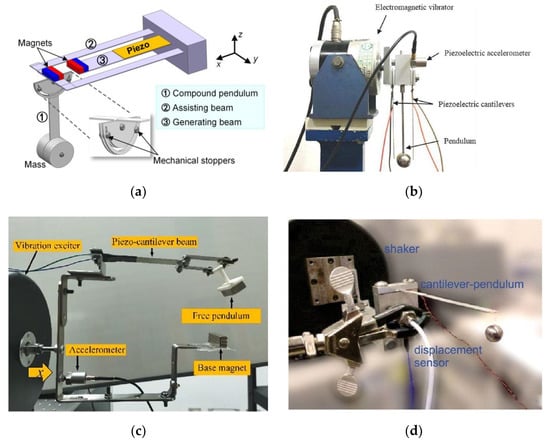
3. Energy harvesters with double pendulum
A double pendulum adds a degree of freedom to the basis of a single pendulum. However, a double pendulum exhibits complicated motion and rich dynamics [107]. Thus, double pendulums have attracted much research attention. A double pendulum comprises two rigid pendulae that can swing freely in the vertical plane. The primary structure of the double pendulum is shown in Figure 15.
Figure 15. Primary based on a structure of double pneumatic peendulum.
Chen et al. [119] proposed a rotational wind energy harvester based on a magnetic double-pendulum system. As shown in Figure 18a, the proposed structure generates electric power by coupling the double pendulum with nonlinear magnetic interaction. Owing to the dynamic characteristics of the double pendulum, this system can reduce the magnetic resistance torque at low rotational speeds. Experimental results indicated that the system was able to generate the maximum output power of 1.25 mW at a rotational speed of 557.31 rpm. Izadgoshasb et al. [120] applied a double pendulum system to human motion energy harvesting, as shown in Figure 18b. The piezoelectric cantilever beam is driven by a double pendulum through magnets. The authors compared three configurations using the mechanical shaker and human motion tests: cantilever beam, single pendulum, and double pendulum. The double pendulum exhibited the best effect. Sun et al. [121] expanded the bandwidth of a piezoelectric energy harvester by utilizing the internal resonance between the double pendulum and cantilever beam (Figure 18c). The experimental results showed that the double-pendulum harvester showed excellent broadband energy harvesting ability. Selyutskiy et al. [122] designed a flow-induced vibration energy harvester based on a double aerodynamic pendulum. In this system, the piezoelectric element is connected to the first pendulum and undergoes deformation under the rotation of the pendulum (Figure 18d). This harvester may be suitable for wind energy harvesting.
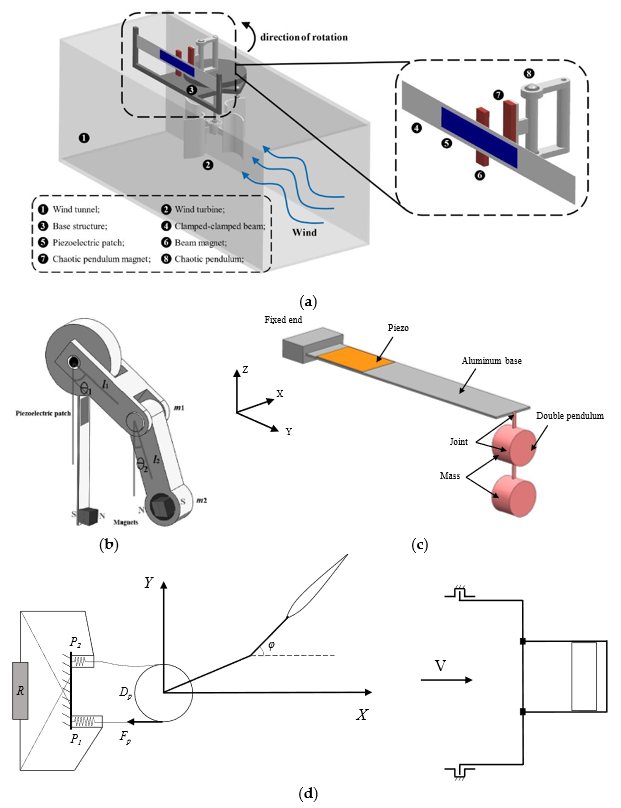
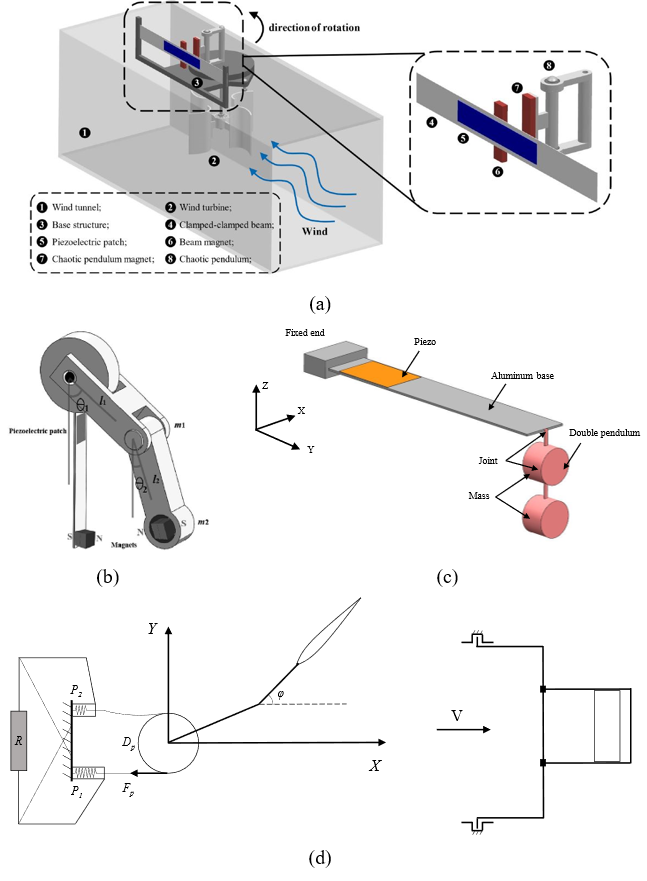 Figure 4. Figure 18. (a) Rotational wind energy harvester based on magnetic double pendulum [1519]. (b) Double-pendulum energy harvester applied in human motion energy conversion [1620]. Reprinted with permission from Ref. [1620]. Copyright 2019, Elsevier. (c) Piezoelectric cantilever beam coupled with double pendulum [1721]. (d) Flow-induced vibration energy harvester based on double aerodynamic pendulum [1822].
Figure 4. Figure 18. (a) Rotational wind energy harvester based on magnetic double pendulum [1519]. (b) Double-pendulum energy harvester applied in human motion energy conversion [1620]. Reprinted with permission from Ref. [1620]. Copyright 2019, Elsevier. (c) Piezoelectric cantilever beam coupled with double pendulum [1721]. (d) Flow-induced vibration energy harvester based on double aerodynamic pendulum [1822].
4. Discussion
- Conclusion
Table 1 summarizes studies on pendulum energy harvesters, primarily including the conversion mechanism, application, working conditions, and output power. In general, studies on the single pendulum are dominant, although a few studies have explored double pendulums. Overall, the double-pendulum systems showed better performance in energy harvesting than the single-pendulum system [114,115]. Thus, research on energy harvesters based on double-pendulum systems warrants further advancement. In particular, pendulum system energy harvesters are primarily applied for the conversion of ultra-low-frequency energy, such as oceanic kinetic and human motion energy. The output power of pendulum-like energy harvesters is mainly concentrated at the milliwatt and microwatt levels, which is suitable for low-power devices.
Table 1. Comparison of various energy harvesters based on pendulum systems.

5. Conclusions
This study reviews the researches on the theoretical analyses of the single and double pendulums and their applications in energy harvesting. The different energy-conversion mechanisms, design schemes, and optimal structures of pendulum-like energy harvesters have been summarized in the literature. Based on the existing research, single-pendulum energy harvesters are predominantly applied in ultra-low-frequency environments and for multi-directional energy harvesting. The working conditions of pendulum energy harvesters are <10 Hz, which mainly include ocean wave and human motion energy. Furthermore, single-pendulum systems can be combined with the other functions, such as mechanical motion rectifiers and structural damping. In addition, energy harvesting based on the double pendulums has attracted much research attention.
R Based on the above summary, we predict several ferenceuture research directions and potential applications of pendulum-type energy harves
- Jia, Y.; Yan, J.Z.; Soga, K.; Seshia, A.A. Parametric resonance for vibration energy harvesting with design techniques to passively reduce the initiation threshold amplitude. Smart Mater. Struct. 2014, 23(6), 065011, https://doi.org/10.1088/0964-1726/23/6/065011.
- Wu, Y.P.; Qiu, J.H.; Zhou, S.P.; Ji, H.L.; Chen, Y.; Li, S. A piezoelectric spring pendulum oscillator used for multi-directional and ultra-low frequency vibration energy harvesting. Energy 2018, 231, 600-14, https://doi.org/10.1016/j.apenergy.2018.09.082.
- Dai, X. An vibration energy harvester with broadband and frequency-doubling characteristics based on rotary pendulums. Actuator A-Phys. 2016, 241, 161-8, https://doi.org/10.1016/j.sna.2016.02.004.
- Kecik, K.; Mitura, A. Energy recovery from a pendulum tuned mass damper with two independent harvesting sources. J. Mech. Sci. 2020, 174, 105568, https://doi.org/10.1016/j.ijmecsci.2020.105568.
- Jahani, K.; Langlois, R.G.; Afagh, F.F. Structural dynamics of offshore Wind Turbines: A review. Ocean Eng. 2022, 251, 111136, https://doi.org/10.1016/j.oceaneng.2022.111136.
- Jahangiri, V.; Sun, C. Integrated bi-directional vibration control and energy harvesting of monopile offshore wind turbines. Ocean Eng. 2019, 178, 260-9, https://doi.org/10.1016/j.oceaneng.2019.02.015.
- Shen, W.A.; Zhu, S.Y.; Xu, Y.L. An experimental study on self-powered vibration control and monitoring system using electromagnetic TMD and wireless sensors. Actuator A-Phys. 2012, 180, 166-76, https://doi.org/10.1016/j.sna.2012.04.011.
- Bao, B.; Wang, Q. Bladeless rotational piezoelectric energy harvester for hydroelectric applications of ultra-low and wide-range flow rates. Energy Conv. Manag. 2021, 227, 113619, https://doi.org/10.1016/j.enconman.2020.113619.
- Prajwal, K.T.; Manickavasagam, K.; Suresh, R. A review on vibration energy harvesting technologies: analysis and technologies. Phys. J.-Spec. Top. 2022, 231(8), 1359-71, https://doi.org/10.1140/epjs/s11734-022-00490-0.
- Covaci, C.; Gontean, A. Piezoelectric Energy Harvesting Solutions: A Review. Sensors 2020, 20(12), 3512, https://doi.org/10.3390/s20123512.
- Toma, D.M.; del Rio, J.; Carbonell-Ventura, M.; Masalles, J.M. Underwater energy harvesting system based on plucked-driven piezoelectrics. In Proceedings of the Oceans 2015 Genova, Ctr Congressi Genova, Genova, ITALY, 18-21 May 2015, https://doi.org/10.1109/OCEANS-Genova.2015.7271599.
- Zhang, T.S.; Tang, M.F.; Li, H.; Li, J.B.; Zou, Y.Q.; Pan, Y.J.; Zhang, Z.T. A Multidirectional Pendulum Kinetic Energy Harvester Based on Homopolar Repulsion for Low-Power Sensors in New Energy Driverless Buses. J. Precis Eng Manuf-Green Technol. 2022, 9(2), 603-18, https://doi.org/10.1007/s40684-021-00344-5.
- Shukla, R.; Bell, A.J. PENDEXE: A novel energy harvesting concept for low frequency human waistline. Actuator A-Phys. 2015, 222, 39-47, https://doi.org/10.1016/j.sna.2014.11.016.
- Bao, B.; Wang, Q.; Wu, N.; Zhou, S. Hand-held piezoelectric energy harvesting structure: Design, dynamic analysis, and experimental validation. Measurement 2021, 174, 109011, https://doi.org/10.1016/j.measurement.2021.109011.
- Chen, J.T.; Bao, B.; Liu, J.L.; Wu, Y.F.; Wang, Q. Piezoelectric energy harvester featuring a magnetic chaotic pendulum. Energy Conv. Manag. 2022, 269, 116155, https://doi.org/10.1016/j.enconman.2022.116155.
- Izadgoshasb, I.; Lim, Y.Y.; Tang, L.H.; Padilla, R.V.; Tang, Z.S.; Sedighi, M. Improving efficiency of piezoelectric based energy harvesting from human motions using double pendulum system. Energy Conv. Manag. 2019, 184, 559-70, https://doi.org/10.1016/j.enconman.2019.02.001.
- Sun, S.; Zheng, Y.; Wang, Y.; Zhang, X. Investigation of internal resonance on widening the bandwidth of energy harvester based on a cantilevered double pendulum structure. AIP Adv. 2022, 12(9), 095108, https://doi.org/10.1063/5.0102817.
- Selyutskiy, Y.D.; Holub, A.P.; Lin, C.H. Piezoaeroelastic system on the basis of a double aerodynamic pendulum. ZAMM-Z. Angew. Math. Mech. 2021, 101(1), e202000092, https://doi.org/10.1002/zamm.202000092.
ters:
- From comparative experimental results, double-pendulum systems perform better than single-pendulum systems in terms of energy harvesting. However, studies on double-pendulum energy harvesters are relatively few, and research on energy harvesters based on double pendulums may be further advanced.
- The combination of a nonlinear structure with a pendulum system energy harvester has been considerably optimized. The introduction of a nonlinear structure can improve the adaptive ability of energy harvesters. From the current studies, the energy harvesting performance can be effectively improved with the reasonable application of nonlinear systems.
- Multi-physics coupling energy harvesting is another research topic. The coupling of different types of energy conversion mechanisms can broaden the operation bandwidth and improve output power.

